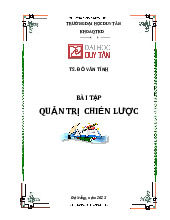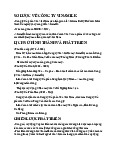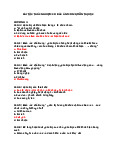



Preview text:
DUY TAN UNIVERSITY
Faculty of Business Administration For Review
I. MULTIPLE CHOICE: Select the best answer and write the letter of your choice (in
capital letter) on your answer sheet. Before writing your answer/s read and
understand the question carefully.
1. A cluster of decisions about what goals to pursue, what actions to take, and how
to use resources to achieve goals pertains to a. Planning c. Organizing b. Strategy d. Decision making.
2. Organizing tools that managers can use to increase communication and
coordination among functions and divisions pertains to a. Allocating authority c. Matrix design b. Product team design d. Integrating mechanism.
3. Which of the following powers of a leader describes the authority that a manager
has by virtue of his or her position in an organization’s hierarchy? a. Reward c. Legitimate b. Coercive d. Expert
4. Which of the following control systems gives managers immediate feedback on
how efficiently inputs are being transformed into outputs so managers can
correct problems as they arise? a. Concurrent c. Feedforward b. Feedback d. Operational control
5. Selling to a foreign organization the rights to use a brand name and operating
know-how in return for a lump-sum payment and a share of the profits defines a. Licensing c. Franchising b. Importation d. Joint venture.
6. The tendency of individuals to put forth less effort when they work in groups than
when they work alone refers to a. Group task c. Role making b. Group role d . . Social loafing
7. Which of the following situational characteristics is described when the extent to
which the work to be performed is clear-cut so that a leader’s subordinates know
what needs to be accomplished and how to go about doing it? a. Leader-member relations c. Position power b. Task structure d. Initiating structure
8. Anything that hampers any stage of the communication process refers to a. Noise c. Sun spot activity b. Delay d. Fault.
9. Which of the following computer based MIS that utilizes human knowledge
embedded in computer software to solve problems that ordinarily require human expertise? a. Artificial intelligence c. Decision support system b. Expert system
d. Transaction processing system
10. Which of the following sources of managerial power that is based on the special
knowledge, skills, and expertise that a leader possesses? a. Expert c. Reward b. Coercive d. Legitimate power
11. A committee of managers or non-managerial employees from various
departments or divisions who meet to solve a specific, mutual problem is called a. Virtual team c. Task force b. Friendship group d. Self-managed work team.
12. Which of the following levels of strategy formulation where a plan of action that
involves choosing in which industries and countries a company should invest its
resources to achieve its mission and goals? a. Functional c. Business b. Division d. Corporate-level
13. Which of the following types of groups describes an informal group of employees
seeking to achieve a common goal related to their membership in an organization? a. Interest group c. Virtual team b. Friendship group d. Self-managed work team
14. The formal written specific guides to action are a. Programs c. Policies b. SOP d. Rules.
15. Which of the following pay and motivation theories describes the condition that
the distribution of outcomes, such as pay, should be contingent on the
performance of organizationally functional behaviors? Goal-setting c. Learning a. Expectancy d. Equity theories
16. It allows managers at all levels to become personally involved with their
subordinates and allows them to mentor subordinates and develop their management skills refers to a. Bureaucratic c. Management by objectives b. Direct supervision d. Dedication.
17. A plan of action to take advantage of favorable opportunities and find ways to
counter threats so as to compete effectively in an industry is a. Business-level c. Corporate-level b. Functional-level
d. Organizational- level strategy.
18. Which type of an organization that has many levels of authority relative to company size? a. Flat c. Tall b. Formal d. Informal organization
19. Which of the following financial measures of performance that measures how
well managers have protected organizational resources to be able to meet short- term obligations? a. Profit c. Activity b. Leverage d. Liquidity ratio
20. An individual based merit plan, managers base employees’ pay on the number of
units each employee produces pertains to a. Commission pay c. The Scanlon plan b. Piece-rate pay d. Profit sharing.
II. Identification: Identify what is being asked and write your answer/s in your answer sheet.
1. A strategy used when entering a new industry or buying a company in a new
industry that is not related in any way to an organization’s current businesses or
industries. unrelated diversification. sai
2. A company specific virtual information system that systematizes the knowledge
of its employees and facilitates the sharing and integration of their expertise. task-oriented leaders sai
3. A financial instrument that entitles the bearer to buy shares of an organization’s
stock at a certain price during a certain period or under certain conditions. Employee Stock Option đúng
4. A goal-setting process in which a manager and each of his or her subordinates
negotiate specific goals and objectives for the subordinate to achieve and then
periodically evaluate the extent to which the subordinate is achieving those goals
Management by Objectives đúng
5. A group of employees who supervise their own activities and monitor the quality
of the goods and services they provide. Self-Managed work team đúng
6. The operations management strategy whose goal is to design the machine—
worker interface to increase production system efficiency. facilities layout đúng
7. Operations management techniques that attempt to reduce the setup costs
associated with a production system. flexible manufacturing đúng
8. A theory that focuses on identifying the types of goals that are most effective in
producing high levels of motivation and performance and explaining why goals
have these effects. False đúng
9. These are shared guidelines or rules for behavior that most group members
follow. Group norms đúng
10. The amount of information that a communication medium can carry and the
extent to which the medium enables the sender and receiver to reach a common
understanding. information richness đúng




